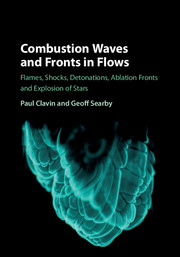 Combustion Waves and Fronts in Flows
Combustion Waves and Fronts in Flows Preface
Published online by Cambridge University Press: 05 August 2016
Summary
Combustion is a fascinating phenomenon coupling complex chemistry to transport mechanisms and nonlinear fluid dynamics. The combustion of reactive mixtures, frozen far from chemical equilibrium, is an irreversible process in which the approach to equilibrium proceeds through the propagation of nonlinear waves in the form of sharp fronts exhibiting complex geometrical forms. These waves were discovered in the nineteenth century, but the understanding of their structure and dynamics is quite recent. In gaseous mixtures, the rate of chemical heat release is small compared with the rate of elastic collisions, so that combustion is described by the macroscopic equations for the conservation of mass, species, momentum and energy, assuming local equilibrium (except for the inner structure of shock waves). The full system of equations is complicated and is not useful to describe each of the elementary phenomena, separate from the others. Even the coupling of two phenomena, as for example a quasi-isobaric flame and acoustic waves, is represented by simplified equations. The major advances have resulted from analytical studies of simplified models performed in close relation to carefully controlled laboratory experiments. A systematic reduction of the complexity of the basic equations, validated by the confrontation with experiments, is the key to understanding. It is also the most difficult step. The analytical and numerical solutions of simplified equations of relevant models can be completed in a second step by direct numerical simulations of a more detailed system of equations.
The book is written along this line and attention is focused on fundamental aspects. It is meant to be a survey of the nonlinear dynamics of combustion waves, which now constitute a mature scientific field. A similar approach is used to improve the understanding of other types of waves such as ablation fonts in inertial confinement fusion. The approach is also tentatively extended to the explosion of stars at the end of their lifetime, the famous supernovae. A large variety of phenomena is presented. The purpose is to provide a wide view of the physical problems involved in different domains that can benefit from cross-fertilisation. The most important scientific results are reported, ranging from the pioneering works of the last century to the advanced research of the last decade.
- Type
- Chapter
- Information
- Combustion Waves and Fronts in FlowsFlames, Shocks, Detonations, Ablation Fronts and Explosion of Stars, pp. ix - xPublisher: Cambridge University PressPrint publication year: 2016


